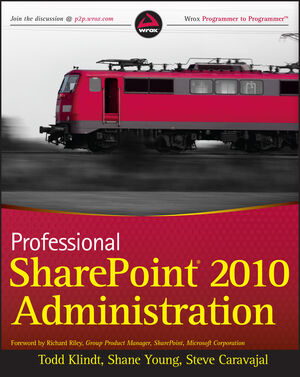Professional SharePoint 2010 AdministrationISBN: 978-0-470-53333-8
Paperback
840 pages
June 2010
 |
||||||
Foreword xxxi
Introduction xxxiii
Chapter 1: What’s New in SharePoint 2010 1
Installation 1
Central Administration 5
Service Applications 7
Windows Identity Foundation and Claims 8
Health and Monitoring 8
Managing SharePoint 2010 with Windows PowerShell 10
Managed Accounts 11
Recovering from Disaster 11
The New and Improved User Experience 12
Summary 13
Chapter 2: The New and Improved User Experience 15
Browser Support 16
Changes to the SharePoint 2010 User Interface 17
Creating a Site 20
Lists and Libraries in SharePoint 2010 21
Working with SharePoint Pages 39
Using Site Templates in SharePoint 2010 48
Multilingual User Interface 51
Summary 58
Architecture a Chapter 3: nd Capacity Planning 59
What’s in a Name? 60
Other Servers 64
Hardware Requirements 68
Terminology 76
Controlling Deployments 80
Summary 83
Chapter 4: Installing and Configuring SharePoint 2010 85
The Prerequisites Installer 86
Running Setup.exe 88
Using the SharePoint 2010 Wizards 95
Central Administration Post-Setup Configuration 101
Step-by-Step Install 102
Creating Something Users Can Use 108
Summary 112
Chapter 5: Upgrading from SharePoint 2007 to SharePoint 2010 113
Upgrade Considerations 113
In-Place Upgrade 117
Database Attach 128
Hybrid Upgrades 132
Database Attach with AAM Redirect 133
Other Upgrade Options 134
Patching SharePoint 2010 138
Summary 140
Chapter 6: Using the New Central Administration 141
A Quick Overview of the New Central Administration Interface 141
First Things First 143
Central Administration Categories 146
Summary 166
Understanding the Chapter 7: Service Application Architecture 167
Farewell to the Shared Services Provider 168
Service Application Fundamentals 170
Service Application Administration 177
Multi-Tenancy in SharePoint 2010 188
Summary 193
Chapter 8: Securing and Managing Site Content 195
Reviewing the Terminology 196
Administration Hierarchy in SharePoint 2010 197
Understanding Permissions 201
Permission Levels 205
Security Groups 211
Granting Permissions 220
Web Application Policy 224
Summary 225
Chapter 9: Claims-Based Authentication 227
Claims-Based Identity 227
SharePoint Authentication Options 231
Creating Claims-Based Web Applications 232
Summary 246
Chapter 10: Administering SharePoint 2010 with Windows PowerShell 247
Introduction to Windows PowerShell 248
Microsoft SharePoint 2010 Management Shell and Other Hosts 248
Commands 252
Basic PowerShell 253
Using SharePoint Commands 261
Summary 281
Chapter 11: Managing Navigation and Understanding Governance 283
Navigation 284
SharePoint Governance 294
Summary 301
Chapter 12: Configuring SharePoint 2010 for High Availability Backups 303
Determining Your Business Requirements 303
Content Recovery 305
Disaster Recovery 324
High Availability 341
Summary 348
Chapter 13: Using Features and Solution Packages 349
Using SharePoint 2010 Features 350
Solutions 359
Summary 369
Chapter 14: Configuring and Managing Enterprise Search 371
The Different Versions of Search 372
SharePoint Foundation Search 372
SharePoint Server and Search Server 378
FAST Search 408
Summary 410
Chapter 15: Monitoring SharePoint 2010 411
Unified Logging Service 411
Summary 443
Chapter 16: Managed Metadata Service App lications 445
Advantages of the Managed Metadata Service 446
New Managed Metadata Service Features 446
Getting Started with the Managed Metadata Service 448
Managed Metadata Services 452
Content Types 463
Summary 469
Chapter 17: Social Computing and SharePoint 2010 471
The User Profile Service Application 472
Tags and Notes 484
My Sites 488
Wikis and Blogs 501
Ratings 505
Outlook 2010 Social Connector 506
People Search 507
Summary 509
Chapter 18: Integrating the Office 2010 Clients with SharePoint 2010 511
Office 2010 Application Commonalities 512
Integrating SharePoint 2010 with Word 2010 519
Integrating SharePoint 2010 with Excel 522
Integrating SharePoint 2010 with PowerPoint 525
Integrating SharePoint 2010 with Outlook 527
Managing SharePoint Alerts 528
Calendars and Meetings 529
Integrating SharePoint 2010 with InfoPath 530
Integrating SharePoint 2010 with Microsoft Visio 536
Integrating SharePoint 2010 with OneNote 537
Integration with Access 2010 and Access Services 538
SharePoint 2010 Workspace 543
Publishing Links to Office Client Applications 545
Managing Office 2010 and SharePoint through Group Policy 546
Summary 549
Chapter 19: The Office Web Applications 551
OWA Overview 551
Deployment 554
OWA Installation 558
OWA PowerShell Activation 579
Summary 584
Chapter 20: PerformancePoint Services and Business Intelligence 585
PPS Features and Terminology 586
PPS Installation and Configuration 587
Introduction to Dashboard Designer 601
Importing PerformancePoint Server 2007 Content to
PerformancePoint Services 2010 612
Summary 616
Chapter 21: New Content Management Capabilities in SharePoint 2010 617
Managed Metadata 618
Document Sets 621
Document ID Service and IDs 629
Content Organizer 635
Summary 646
Chapter 22: Working with SharePoint Designer 2010 647
Who Should Use SharePoint Designer? 648
Introduction to SharePoint Designer 2010 649
Overview of the New UX 650
Restricting Access to SharePoint Designer 655
What Can You Do with SharePoint Designer 2010? 658
Summary 681
Chapter 23: Branding SharePoint 2010 683
What Is Branding? 683
Understanding Your Requirements 684
SharePoint Versions and Publishing 684
Types of SharePoint Sites: Internet versus Intranet 690
Branding Basics for SharePoint 2010 694
Summary 721
Chapter 24: Business Connectivity Services in SharePoint 2010
723
Capability Overview 724
Architecture 726
Creating a BCS Solution 731
Service Applications That Use BCS 741
Design Considerations for BCS Solutions 742
Upgrading the Business Data Catalog to BCS 743
Summary 744
Chapter 25: Building Workflows in SharePoint 2010 745
Why Use Workflow? 746
Windows Workflow Foundation 746
Workflow Basics 747
Configuring Workflows Using the Browser 751
Workflow Tools in SharePoint Designer 2010 758
Workflow Visualization Using Visio Premium 2010 765
Using Visual Studio 2010 to Create Workflows 766
Selecting a Workflow Method 766
Summary 767
Index 769



